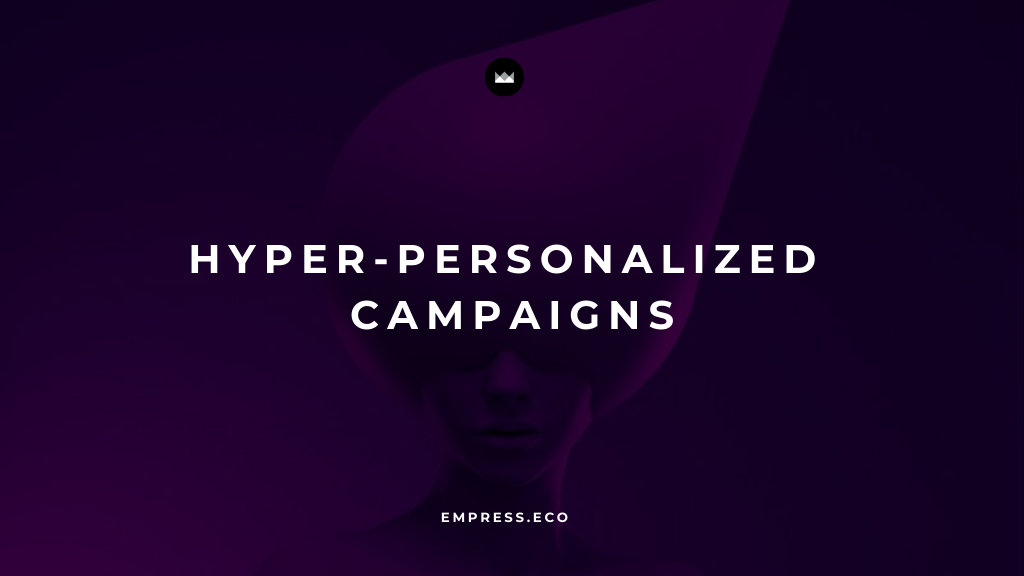
Hyper-Personalized Campaigns for Lead Generation
Crafting Marketing Strategies Tailored to Customer Preferences
Table of Contents
In the world of marketing, one size no longer fits all. Customers today expect more than just generic offers and blanket messaging—they want experiences that speak directly to their needs, interests, and preferences. Enter hyper-personalized campaigns, a cutting-edge approach that allows businesses to deliver highly customized marketing experiences. By harnessing the power of data and advanced analytics, you can create campaigns that not only capture attention but also drive meaningful engagement and conversions.
Let’s explore how you can design and implement hyper-personalized campaigns that will elevate your marketing efforts and build stronger relationships with your customers.
Why Hyper-Personalized Campaigns Matter
Before we get into the nuts and bolts of creating these campaigns, it’s important to understand why hyper-personalization is so crucial in today’s market. Think about the last time you received an email or saw an ad that seemed like it was made just for you—perhaps it highlighted a product you’d been searching for or offered a discount on something you’ve been eyeing. How did it make you feel? More likely than not, it caught your attention and made you more inclined to take action.
That’s the power of personalization.
Hyper-personalization takes this concept to the next level by using real-time data to tailor content and offers at an individual level. This isn’t just about knowing a customer’s name; it’s about understanding their behaviors, preferences, and even predicting what they might need next. The result? A more engaging and effective marketing strategy that feels less like marketing and more like a helpful suggestion from a trusted friend.
Key Benefits of Hyper-Personalized Campaigns
Let’s break down the key benefits that make hyper-personalized campaigns a must-have in your marketing toolkit.
1. Increased Customer Engagement
When content is relevant, it’s naturally more engaging. Personalized content aligns with customer interests and behaviors, capturing attention far more effectively than generic messaging ever could. This heightened engagement translates into tangible results, like higher click-through rates, longer interaction times, and increased customer satisfaction.
Imagine you’re running an online clothing store. Instead of sending a generic email about your new summer collection to your entire mailing list, you could segment your audience based on past purchases and browsing behavior. Customers who have previously bought swimwear might receive a personalized email featuring your latest swimsuits, while those who’ve shown interest in activewear might see your new range of sportswear. By aligning your content with each customer’s interests, you’re far more likely to capture their attention and encourage them to explore your offerings.
2. Improved Conversion Rates
Personalization isn’t just about making your customers feel good—it’s also about driving action. Hyper-personalized campaigns deliver relevant offers and messages that speak directly to a customer’s specific needs and preferences. When a customer sees content that resonates with them, they’re more likely to take the desired action, whether that’s clicking on a link, signing up for a service, or making a purchase.
For example, a customer who frequently buys skincare products from your store might receive a special offer on a new serum that complements the products they already use. Because the offer is tailored to their preferences, they’re more likely to respond positively and make a purchase, boosting your conversion rates.
3. Enhanced Customer Loyalty
Loyalty is built on trust and positive experiences. When customers feel understood and valued by your brand, they’re more likely to remain loyal over the long term. Hyper-personalization fosters this sense of connection by consistently delivering value through tailored experiences that meet or exceed customer expectations.
Consider a scenario where a customer regularly purchases dog food from your online pet store. By sending them timely reminders when it’s time to reorder, along with personalized recommendations for other pet products based on their past purchases, you’re not only making their life easier but also strengthening their loyalty to your brand. Over time, this customer is more likely to think of your store first whenever they need something for their pet, because they know you offer exactly what they’re looking for.
4. Efficient Use of Marketing Resources
One of the significant advantages of hyper-personalization is the ability to focus your marketing efforts where they’re most likely to pay off. Targeting high-potential segments with personalized messaging allows you to optimize your resource allocation, ensuring that your time, budget, and efforts are directed towards campaigns that are more likely to yield a high return on investment (ROI).
Instead of spreading your marketing resources thin across broad, untargeted campaigns, hyper-personalized strategies enable you to concentrate on the customers who are most likely to convert. This not only improves your marketing efficiency but also maximizes the impact of each campaign.
Implementing Hyper-Personalized Campaigns: A Step-by-Step Guide
Now that you understand the benefits, let’s walk through how to implement hyper-personalized campaigns in your own marketing strategy. While the process can seem complex, breaking it down into manageable steps can make it much more straightforward.
Step 1: Data Collection and Analysis
The foundation of any hyper-personalized campaign is data—specifically, detailed customer data. This data is what allows you to understand your customers on a granular level and create campaigns that resonate with them.
Here’s how to get started:
- Gather Data from Multiple Touchpoints: Collect data from every interaction your customers have with your brand, including purchase history, browsing behavior, social media interactions, email engagement, and customer service inquiries. The more data points you have, the better you’ll be able to understand your customers’ preferences and behaviors.
- Use Advanced Analytics: Once you’ve gathered the data, use advanced analytics tools to identify patterns and trends. For example, you might notice that customers who purchase certain products often buy complementary items within a few weeks. Or you might find that customers who engage with your brand on social media are more likely to respond to email offers. These insights are invaluable for informing your personalization efforts.
- Create Customer Profiles: Develop detailed customer profiles based on the data you’ve collected. These profiles should include demographic information, purchasing habits, preferences, and any other relevant data that can help you tailor your campaigns.
Step 2: Segmentation and Targeting
With your customer data in hand, the next step is to segment your audience into distinct groups based on shared characteristics and behaviors. Segmentation allows you to create targeted messaging and offers that are relevant to each group, ensuring that your campaigns resonate with the right people.
Here’s how to approach segmentation:
- Identify Key Segments: Start by identifying the most important segments within your customer base. This could be based on demographics (e.g., age, gender, location), behavior (e.g., purchase history, browsing habits), or a combination of factors.
- Develop Targeted Messaging: Once you’ve identified your segments, create tailored messaging for each group. For example, if you’re targeting a segment of young professionals, your messaging might focus on convenience and style. If you’re targeting parents, you might emphasize value and quality.
- Align Offers with Customer Needs: Ensure that the offers you present to each segment align with their specific needs and preferences. For example, a discount on baby products might resonate more with parents, while a limited-time offer on travel accessories might appeal to frequent travelers.
Step 3: Dynamic Content Creation
One of the most powerful tools in your hyper-personalization toolkit is dynamic content. This refers to content that automatically adjusts based on real-time customer data, allowing you to deliver personalized experiences across different channels and touchpoints.
Here’s how to implement dynamic content:
- Use Dynamic Content Tools: Platforms like HubSpot, Marketo, and Salesforce offer dynamic content tools that can automatically tailor your messaging and offers based on the customer’s behavior, preferences, and past interactions.
- Personalize Across Channels: Ensure that your dynamic content is consistent across all your marketing channels—whether it’s email, website, social media, or mobile apps. For example, if a customer abandons their shopping cart on your website, they might receive a personalized follow-up email with a discount on the items they left behind.
- Leverage Real-Time Data: Use real-time data to trigger dynamic content in response to customer actions. For example, if a customer clicks on a particular product category on your website, you could dynamically update the page to highlight similar products or special offers related to that category.
Step 4: A/B Testing and Optimization
No campaign is perfect right out of the gate. A/B testing allows you to experiment with different versions of your personalized campaigns to see what works best. By testing and optimizing your campaigns, you can continuously improve their effectiveness and ensure that you’re delivering the best possible experience to your customers.
Here’s how to conduct A/B testing:
- Test Different Variables: A/B testing involves comparing two or more versions of a campaign to see which one performs better. You can test various elements, such as subject lines, call-to-action buttons, images, and offers. For example, you might test two different email subject lines to see which one results in a higher open rate.
- Analyze the Results: Use analytics tools to track the performance of each version of your campaign. Pay attention to key metrics like click-through rates, conversion rates, and customer engagement.
- Iterate and Improve: Based on the results of your A/B tests, make adjustments to your campaigns. For example, if one subject line outperforms another, you might use that subject line as a template for future emails. The goal is to continually refine your campaigns to maximize their effectiveness.
Challenges and Considerations in Hyper-Personalization
While hyper-personalized campaigns offer numerous benefits, they also come with their own set of challenges. Being aware of these challenges will help you navigate the process more effectively.
1. Data Privacy and Compliance
When dealing with large amounts of customer data, privacy and compliance are paramount. It’s essential to ensure that your data collection and personalization efforts comply with relevant regulations, such as GDPR or CCPA.
Steps to ensure compliance include:
- Transparent Data Practices: Clearly communicate how you collect, store, and use customer data. Ensure that customers have the option to opt-in or opt-out of data collection.
- Data Protection Measures: Implement robust security measures to protect customer data, including encryption, access controls, and regular audits.
- Respect Customer Preferences: Always respect customer preferences when it comes to data usage. If a customer requests not to receive personalized offers, ensure that their request is honored.
2. Complexity and Scalability
As your customer base grows, managing personalized campaigns can become increasingly complex. It’s important to invest in scalable systems and processes that allow you to maintain personalization at scale.
Strategies to manage complexity include:
- Automate Where Possible: Use automation tools to manage routine tasks, such as data collection, segmentation, and content delivery. This reduces the manual workload and allows you to focus on strategy.
- Scalable Infrastructure: Invest in scalable infrastructure, such as cloud-based platforms, that can handle increased data volumes and support real-time personalization.
- Streamlined Processes: Develop streamlined processes for creating and managing personalized campaigns. This might involve setting up templates, workflows, and standard operating procedures to ensure consistency and efficiency.
3. Balancing Personalization and Privacy
While personalization can greatly enhance customer experiences, it’s important not to overstep boundaries. Customers value their privacy, and overly intrusive personalization can sometimes feel like a breach of trust.
Finding the right balance involves:
- Sensitivity to Customer Preferences: Be mindful of how much personalization is appropriate. For example, while it’s helpful to recommend products based on past purchases, it might be seen as invasive to track every click and interaction.
- Respecting Boundaries: Avoid using data in ways that could make customers uncomfortable. Always ask yourself whether the level of personalization you’re implementing adds value to the customer experience.
- Transparency and Trust: Build trust by being transparent about how you use customer data. Ensure that your customers understand the benefits of personalization and feel confident that their data is being used responsibly.
Conclusion: The Future of Marketing is Hyper-Personalized
Hyper-personalized campaigns are more than just a trend—they represent the future of marketing. As customers continue to expect more tailored and relevant experiences, businesses that embrace hyper-personalization will be better positioned to meet these expectations and stand out in a crowded market.
By leveraging data and advanced analytics to create personalized messaging and offers, you can increase customer engagement, improve conversion rates, and build lasting relationships. However, it’s important to approach hyper-personalization with a clear strategy, a focus on data privacy, and a commitment to ongoing optimization.
In summary:
- Hyper-personalization drives deeper customer engagement by delivering relevant content and offers.
- Improved conversion rates result from campaigns that speak directly to individual customer needs and preferences.
- Customer loyalty is strengthened through consistent, personalized interactions that add value to the customer experience.
- Scalability and compliance are key to successfully managing personalized campaigns as your business grows.
By implementing the strategies outlined in this guide, your business can harness the power of hyper-personalized campaigns to achieve greater marketing success and foster stronger customer connections. As you continue to refine your approach, you’ll find that the rewards of personalization extend far beyond individual campaigns, ultimately contributing to the long-term growth and sustainability of your brand.
Empress Newsletter
Join the newsletter to receive the latest updates in your inbox.



